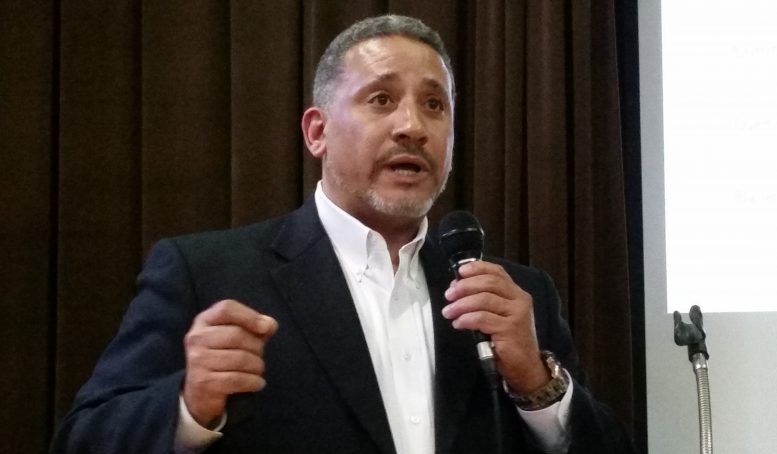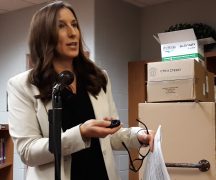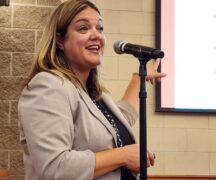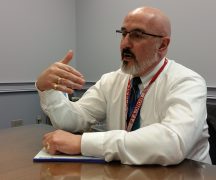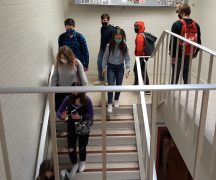By JAN LARSON McLAUGHLIN
BG Independent News
A man who makes his living getting schools and governmental entities out of sticky financial situations has issued his verdict – Bowling Green City School District manages its money well, has tax levels lower than most in the region, and is asking for the right tax to fund its building project.
David Conley, president of Rockmill Financial, was hired by the district to examine a question raised by citizens. Would an income tax be better than a property tax to finance the $72 million building project to consolidate the elementary schools plus add onto and renovate the high school?
“I commend the board for making that decision” to have the issue researched. Many districts would “brush it under the rug,” Conley said during a community meeting Thursday evening.
What he found was that a property tax is more fair to the majority of people in the school district.
“The property tax they’ve put on the table in front of the community is the best funding option at this time,” he said. The bond issue will appear on the May 8 ballot.
To fund the building project with a property tax, it would take 5.7 mills over 37 years. That would mean the owner of a $156,600 home would pay $26.03 a month. For an elderly person, that could decrease to $21.88 a month, Conley said.
To fund the project with income tax, it would cost the average family $41.25 per month. It would require a three-quarter percent income tax for 20 years. Using an income tax would make Bowling Green among the least affordable school districts in the region – second only to Ottawa Hills, Conley said.
“The increased cost of $15 a month wouldn’t be advisable,” he said.
A property tax is more affordable since it is paid by residents and businesses, he said.
“Property tax spreads the tax to more taxpayers.”
Richard Chamberlain, an outspoken critic of the property tax, pointed out that the income tax for 20 years will generate $105 million, while the property tax for 37 years will generate $141 million. Conley agreed with the numbers, but said the property tax is much more affordable for the average income families in the district.
“You have more income than most people,” Conley said to Chamberlain.
“How do you know that?” Chamberlain asked.
“I know you,” Conley replied.
Chamberlain also tried to say the district was not using available state facilities funding – but Conley repeatedly corrected him by saying the district is not eligible now for the funding, and it would be years before it might be.
The district has also been criticized for stretching the bond issue over 37 years to make it more affordable for residents. However, Conley said the majority of school districts in Ohio pay off their buildings in 35 to 37 years.
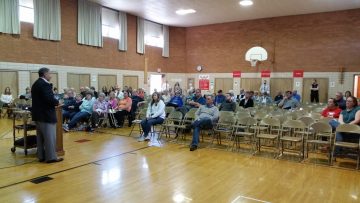
Meeting in Conneaut Elementary gym
Conley, who is being paid $40,000 by the district for the year, said he is now acting as an overseer of school tax dollars.
“I actually represent you in that regard,” he said to the audience at Conneaut Elementary to hear his presentation.
Under state law, Conley said, the district can’t use income tax to purchase bonds unless it is in the state facilities program or exceptional needs program. Bowling Green is in neither.
The district could possibly get into the expedited local partnership program, which would give the district credit down the road 10 to 15 years. However, that would not be a certainty, and would require the district to follow state design specification which would drive up building costs, Conley said. If the district did get credit, it would be for an estimated 15 percent of the project cost.
The district could use income tax to build using a lease-purchase program. This also is unadvisable in most situations, Conley said, since the district would not own its buildings and could be evicted for failure to pay rent.
“You want to use those as a last resort financing option,” he said. “As a finance expert, I would not recommend the use of a lease-purchase.”
Conley then talked about the impacts of both income taxes and property taxes on the district.
School income taxes are paid only by people who live in the district. Businesses do not pay. All income except Social Security is taxed. In order to pay for the school building plans, the district would need a three-quarters percent income tax on top of its existing one-half percent.
Property taxes are paid on residential, agricultural, commercial, industrial, and public utility real estate in the district. Exempt are non-profits, healthcare, governments and universities. Residents who are 65 and older, low income, and with some disabilities can get reductions.
The local economic and demographic indicators show some troubling trends for the district, according to Conley. From 2010 to 2016, the median family incomes and median home values have dropped in the district.
The number of housing units with mortgages is down, indicating older homeowners. And renter occupied housing has grown to 53.7 percent, compared to a state average of 24 percent.
“I don’t think I’ve ever seen one that high,” Conley.
The average family size has increased, while the number of people with bachelor’s degrees has decreased. The number of people in poverty has grown 12 percent in the district.
“The majority of people here aren’t making great money,” he said.
The proposed property tax would collect 59 percent of its total revenue from homeowners, 31 percent businesses and 10 percent from agriculture.
Using current tax affordability statistics, Bowling Green School District now ranks fifth best of the 16 area school districts. The district’s annual expenditure per pupil is $10,551 compared to the state average of $11,603.
If the voters passed the property tax, the affordability would slip to 10th of 16. An income tax would cause it to slip even further to 15th of 16 area school districts.
Conley also cautioned the audience that time is not on the district’s side. Just since the levy failed in November, the higher interest rates have made the project more expensive.
“Timing alone has cost you $4 million,” he said, noting that interest could come down again – but that is not likely anytime soon.
Construction costs are also increasing and adding to the project expenses as time passes, he said. Plus unfunded state mandates could add further costs for school storm shelters and security measures.
New schools are also a good investment in the community, Conley said. Though he had no statistics, new school buildings create more jobs, higher home values, and draw in new families.
“They support the overall financial strength of the community,” he said.
Despite some citizen accusations last week that the district has mismanaged money, Conley’s presentation showed the contrary.
“The district is very well managed financially,” he said. “They are incredibly conservative with taxpayer dollars.”
At last week’s meeting during the school levy discussion, the district was criticized for having $13 million in the bank – yet asking voters for more. Conley said that money is there for school operations, including teacher salaries.
“I wouldn’t recommend that it’s used for constructing school facilities,” Conley said.
Retired teacher Irene Hinesman asked about the district’s financial forecast which predicts deficit spending in five years. She voiced concerns about the district being “house rich” if the levy passes, but lacking funds for operations.
Conley explained the district’s financial forecast is typical for Ohio school districts.
“It’s a part of your normal operating cycle,” he said. The district will likely come back to the voters with a request for an operating levy at that point.
“Every single school district in the state of Ohio” is in the same situation, he said.
Richard Strow asked about the risk of “levy fatigue” since the district will have to come back to the voters in a few years.
“There is no money there for increases for the teachers,” he said.
But Conley said most voters understand the difference between a bond issue for buildings and an operating levy.
“I think a lot of voters separate those in their minds,” he said.
Another citizen asked about the likelihood of a building expansion being needed before this project is paid off. Conley said the current building project has room for expansion built into it.
Steve Bateson pointed out that to some in the district, the primary concern isn’t the tax dollars, but the plan for a centralized elementary. “Not all people agree this is the right plan,” he said.
Bateson also asked if Conley was aware of two pipelines being constructed through the southern part of the school district that would bring in more tax revenue.
Conley said those extra dollars could help drop the costs for others.
“All of those things will help lower the taxes for residents going forward,” he said. However, he cautioned about counting on pipeline tax revenue. “Until it shows up, we don’t know it’s going to show up.”
Another resident asked about seeing bids for the projects. Conley said the bid process will be very public.
To allow the public to get a better look at the condition of the aging school buildings, tours will be offered this Saturday, from 10 to 11:30 a.m. in the high school, 12 to 1:30 p.m. in Kenwood Elementary, and 2 to 3:30 p.m. in Conneaut Elementary.

